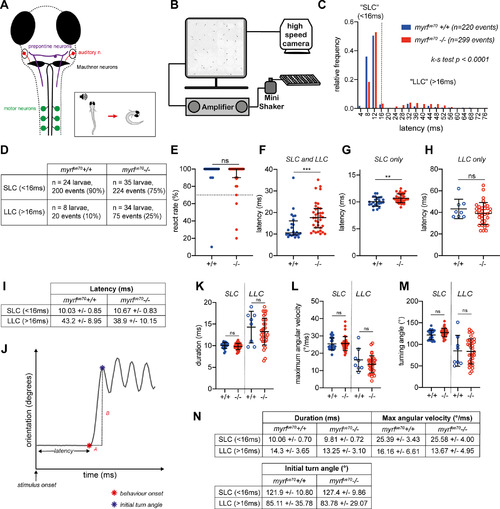Figure 4.
- ID
- ZDB-FIG-211111-61
- Publication
- Madden et al., 2021 - Central nervous system hypomyelination disrupts axonal conduction and behaviour in larval zebrafish
- Other Figures
- All Figure Page
- Back to All Figure Page
|
myrfue70 mutants exhibit increased latency to perform startle responses, and a tendency to perform avoidance behavior, in response to defined acoustic stimuli. A, Overview of the neuronal circuitry involved in motor response to auditory stimuli. Startle response (SLC): sensory input from the ear, via the auditory nerve (red), is received at the lateral dendrite of the Mauthner cell body (black). The axon of the Mauthner cell crosses into the contralateral aspect of the spinal cord where it extends along the ventral tract to recruit motor neurons directly along the length of the larvae. Recruitment of motor neurons allows muscle contraction on the side of the body contralateral to the stimulus, allowing a rapid, high-velocity c-bend (motor response) away from the stimulus (inset). Avoidance behavior (LLC): sensory input is detected by prepontine neurons (purple) in the hindbrain, which recruit ipsilateral motor neurons indirectly, resulting in a low-velocity, longer latency, c-bend away from the stimulus. B, Schematic of the behavioral rig. C, Relative frequency histogram displaying the distribution of latencies for behavioral responses in response to acoustic stimuli in wild-type and mutant larvae (N = 24 wild-type larvae, n = 220 events; N = 35 mutant larvae, n = 299 events; Kolmogorov–Smirnov test, p ≤ 0.0001). D, Number and proportion of events (SLC vs LLC) per genotype. E, React rate per fish (median react rate = 100% in both wild types and mutants, p = 0.24, Mann–Whitney test, N = 25 wild-type larvae, N = 38 mutant larvae). Larvae are excluded from subsequent analysis if they exhibit a react rate <70%. F, Average latency values per fish [wild type: 10.55 ms (9.6–16.15 ms), mutants: 17.6 ms (12.9–21.88 ms), p = 0.003, Mann–Whitney test]. G, Average latency of SLC (<16 ms; wild types: 10.03 ± 0.85 ms, mutants: 10.67 ± 0.83 ms, p = 0.006, unpaired t test). H, Average latency of LLC (>16 ms; wild types: 43.20 ± 8.95 ms; mutants: 38.91 ± 10.15 ms, p = 0.28, unpaired t test). I, Mean and SDs values for SLC and LLC responses per genotype. J–M, Analysis of c-bend kinematics. J, Example trace of orientation over time during a behavioral response to an acoustic stimulus. C-bend kinematics are calculated from individual traces for each response per fish. Latency is the time from stimulus onset to behavioral onset (red star). C-bend duration (A) is time from behavior onset to initial turn angle (blue star). Maximum angular velocity is defined as the change in orientation over time (B/A). Turning angle equates to the initial turn angle. K, Initial turn duration (SLC: wild types: 10.06 ± 0.70 ms, mutants: 9.81 ± 0.72 ms, p = 0.20, unpaired t test; LLC: wild types: 14.30 ± 3.65 ms, mutants: 13.25 ± 3.10, p = 0.42, unpaired t test). L, Maximum angular velocity [SLC: wild types: 24°/ms (22.78–28.68°/ms), mutants: 25°/ms (23.10–26.60°/ms), p = 0.73, Mann–Whitney test; LLC: wild types: 16.16 ± 6.61°/ms, mutants: 13.67 ± 4.95°/ms, p = 0.24, unpaired t test]. M, Initial turn angle (SLC: wild types: 121.9 ± 10.80°, mutants: 127.4 ± 9.86°, p = 0.051, unpaired t test; LLC: wild types: 85.11 ± 35.78°, mutants: 83.78 ± 29.07°, p = 0.91, unpaired t test). N, Descriptive statistics (mean ± SD) for c-bend kinematics. For G–H, K–M, SLCs, N = 24 wild types, N = 35 mutant larvae, LLCs, N = 8 wild-types, N = 34 mutant larvae. For E, F, L, values represent median and interquartile range; for G–I, K and M values represent mean ± SD. |
| Fish: | |
|---|---|
| Observed In: | |
| Stage Range: | Day 5 to Day 6 |

